Which plugin should you choose to manage the SEO of your WordPress site? The time when you had the choice between Yoast SEO and… Yoast SEO seems to be over.
The directory dedicated to SEO plugins of your favorite CMS is seriously growing.
You are now spoilt for choice.

On this blog, we have for example talked about the challenger Rank Math which is rapidly gaining visibility.
Today, in this SEOPress review, we’ll talk about a serious French alternative to other SEO plugins.
Overview
Originally written in March 2020, this article has been updated in September 2021, using version 5.1 of the plugin.
Your best WordPress projects need the best host!
WPMarmite recommends Bluehost: great performance, great support. All you need for a great start.

SEOPress, what is it?
 100vw, 1934px” data-lazy-src=”https://wpmarmite.com/wp-content/uploads/2021/09/seopress-plugin-download.png” /></figure></div><p>Launched in October 2018, SEOPress is a WordPress <a href=) plugin 100% made in France, developed by Benjamin Denis.
plugin 100% made in France, developed by Benjamin Denis.Its reputation is solid: with more than 200,000 active installations for its free version, it enjoys an excellent user rating (4.9/5 out of nearly 800 reviews at the time of writing).
User reviews are at the heart of the constant improvement of this WordPress plugin.
The philosophy of its creator is to “constantly optimizing and simplifying the user interface with both beginners and experienced SEOs in mind”.
The plugin is built on a freemium model:
- A free version with basic features.
- A premium version (at $39 per year for an unlimited number of sites).
Moreover, SEOPress is multilingual and available in more than 20 languages.
 SEOPress review: features of the plugin
SEOPress review: features of the pluginIn its free version, we find classic features to manage the SEO of a site:
- The possibility to import metadata from other SEO plugins, such as Yoast SEO or Rank Math.
- The management of title tags, meta description, meta robots, Open Graph, Google Knowledge Graph…
- The possibility to create your XML sitemap and HTML to better satisfy search engines.
- The connection with Google Analytics and Google Search Console to follow the activity of your visitors.
- A content analysis tool with unlimited keywords: thanks to the recent evolution, it has two indicators: “Good” (yellow or green dots) and “Should be improved” (red or orange dots).
- The possibility to manage ads via Google Ads.
- Google Tag Manager (allows to manage tags without modifying the code).
- Import/export of parameters.
- Google Local Business data type.
- The possibility to redirect attachment pages to the parent post or media file URL.
- The use of the plugin as a white label. This means for example that you will not find any advertisements in the administration or on the visible interface of your site and can remove all references to SEOPress.
SEOPress intends to stand out by not collecting any data from your website: you remain the owner.
To go further, among its paying features, we find:
- Import of metadata from a CSV file.
- Google structured data types (schemas).
- Google Suggestions.
- SEOPress BOT, to detect and repair broken links.
- XML Video sitemap.
- Google Analytics statistics in the WordPress dashboard.
- 301, 302, 307, 410, 451 redirects.
- The possibility to edit your robots.txt and .htaccess files.
- The breadcrumb trail.
- Google Page Speed, to test the loading time of your site.
- Integration with WooCommerce, which allows you to index the elements of your online store à la carte (such as identifying product types or disabling the exploration of the shopping cart page).
- An even more advanced integration with Google Analytics. Thanks to SEOPress, it is for example possible to access your Analytics stats on your WordPress dashboard. And if you use WooCommerce, you can send your product data to Google Analytics to measure your purchases, additions/deletions to the cart, etc.
- 404 error tracking.
- URL rewriting.
How to install the SEOPress plugin step by step?
Before you start, make sure to deactivate other active SEO plugins before activating SEOPress. This is important to avoid conflicts between plugins that may not work well together and cause errors on your website.
The setup is done via an installation wizard, divided into 4 steps.
Step 1: Importing SEO settings
First, SEOPress offers you to import your settings and data from other SEO plugins. There are 12 in total, including the most famous: Yoast, All in One, Rank Math, The SEO Framework, Squirrly, etc.
The goal: “to maintain your SEO” so as not to impact your ranking on search engines.
 100vw, 1962px” data-lazy-src=”https://wpmarmite.com/wp-content/uploads/2021/09/seopress-import-seo-settings.jpg” /></figure></div><h3>Step 2: Configuring your site data</h3><p>Next, <strong>you can set up the data related to your site, for the Google Knowledge Graph</strong>.</p><p>For your information, the Knowledge Graph is a Google feature that allows the search engine to display additional information about you or your brand/company to the right of the search results.</p><p>It is also at this stage that you can fill in your social network profiles.</p><div class=)
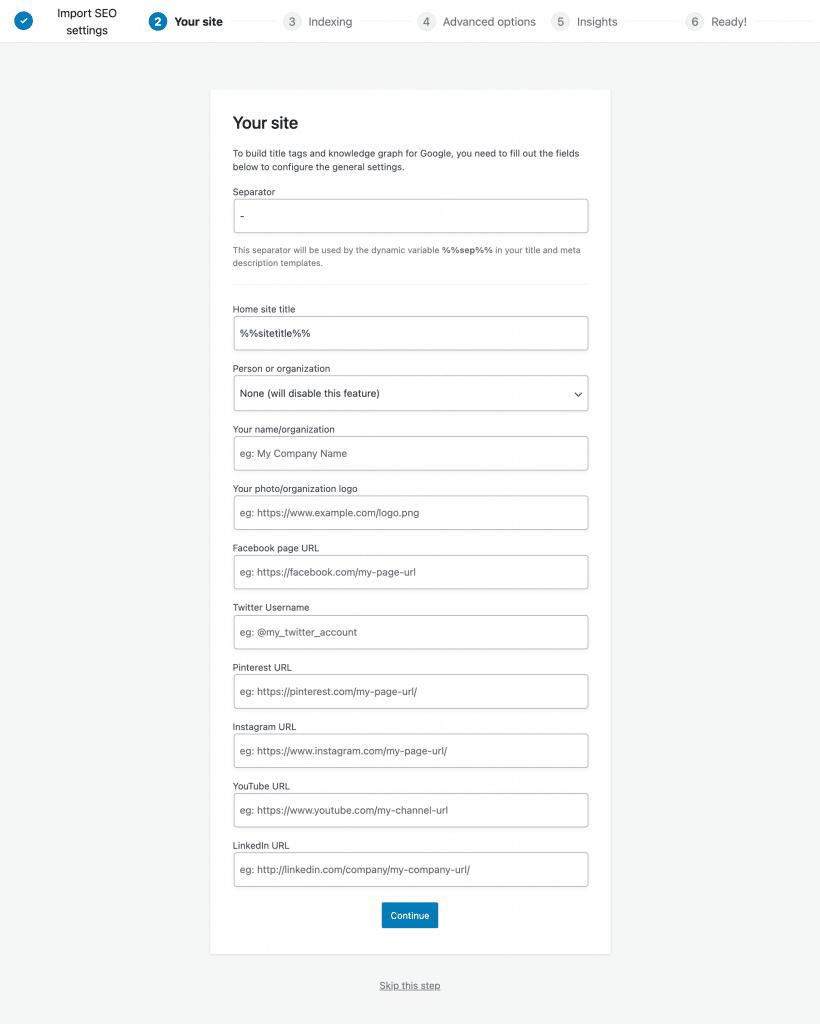
Step 3: Indexing your site
In the third step, the SEOPress installation wizard invites you to specify to search engines what you want to index or not.
It is important to know that in order for your site’s content to have a chance of being indexed, it must first be indexed by a search engine, i.e. stored in an index, a giant database, to put it simply.
It is in this index that a search engine like the giant Google looks for the results that it will then display in its results pages.
By default, all types of publications on your site, the most popular being posts and pages, will be indexed.
If this option does not suit you, check the corresponding box(es). But in this case, be careful: the publications concerned will not appear on search engines.
You can of course modify your settings later on, on your dashboard.
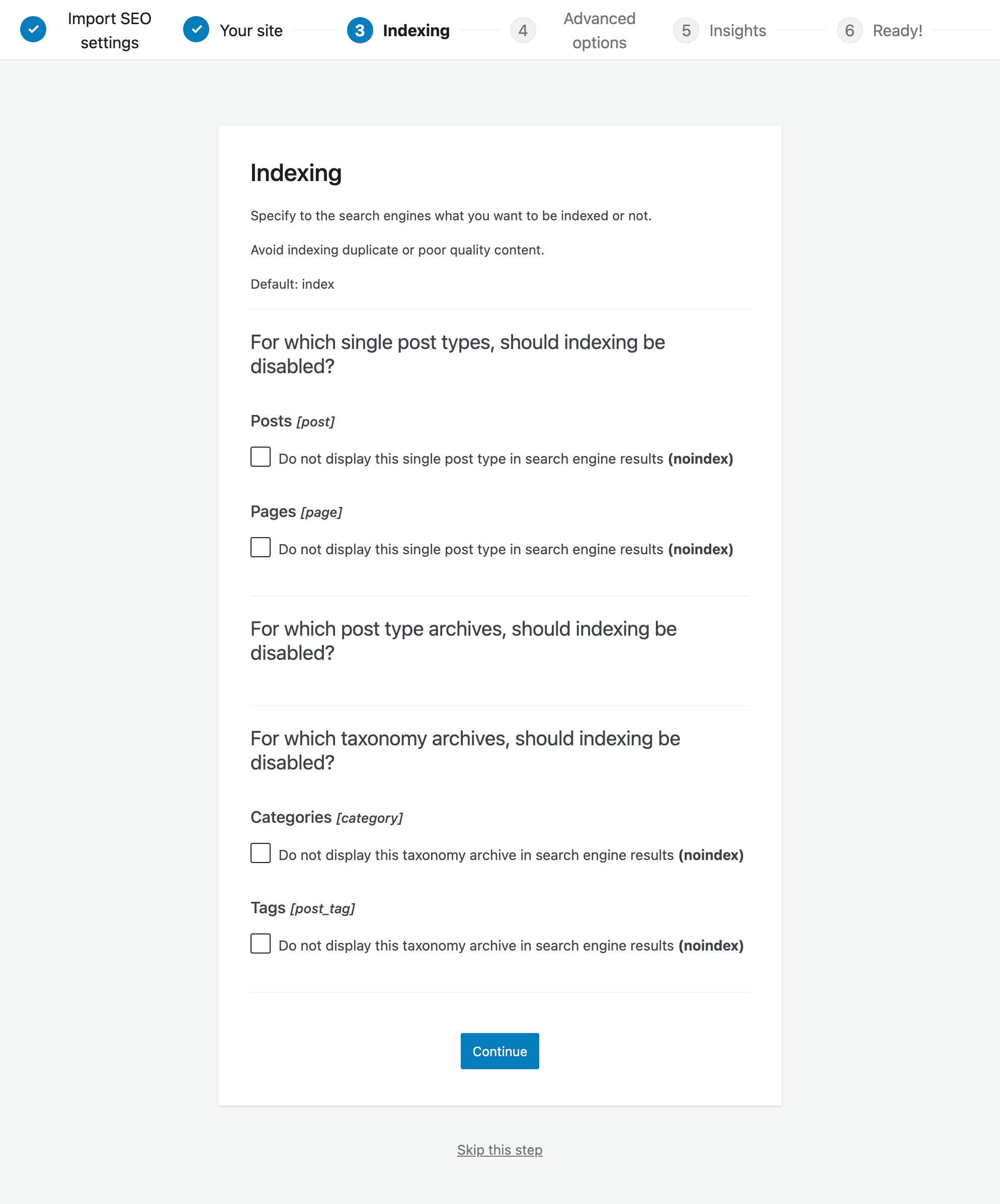
Step 4: Configuring advanced options
In step 4, you can for example :
- Not index the author’s archive in the search engine results.
- Redirect file attachment pages to the file URL.
- Shorten the permalinks of your URLs by deleting /category/.
- Choose to use the universal SEO metabox from SEOPress (we’ll come back to this in detail later in this article), etc.
You can leave the default settings that are proposed to you, knowing, once again, that you can change each setting later. Nothing is final at this stage, don’t worry!
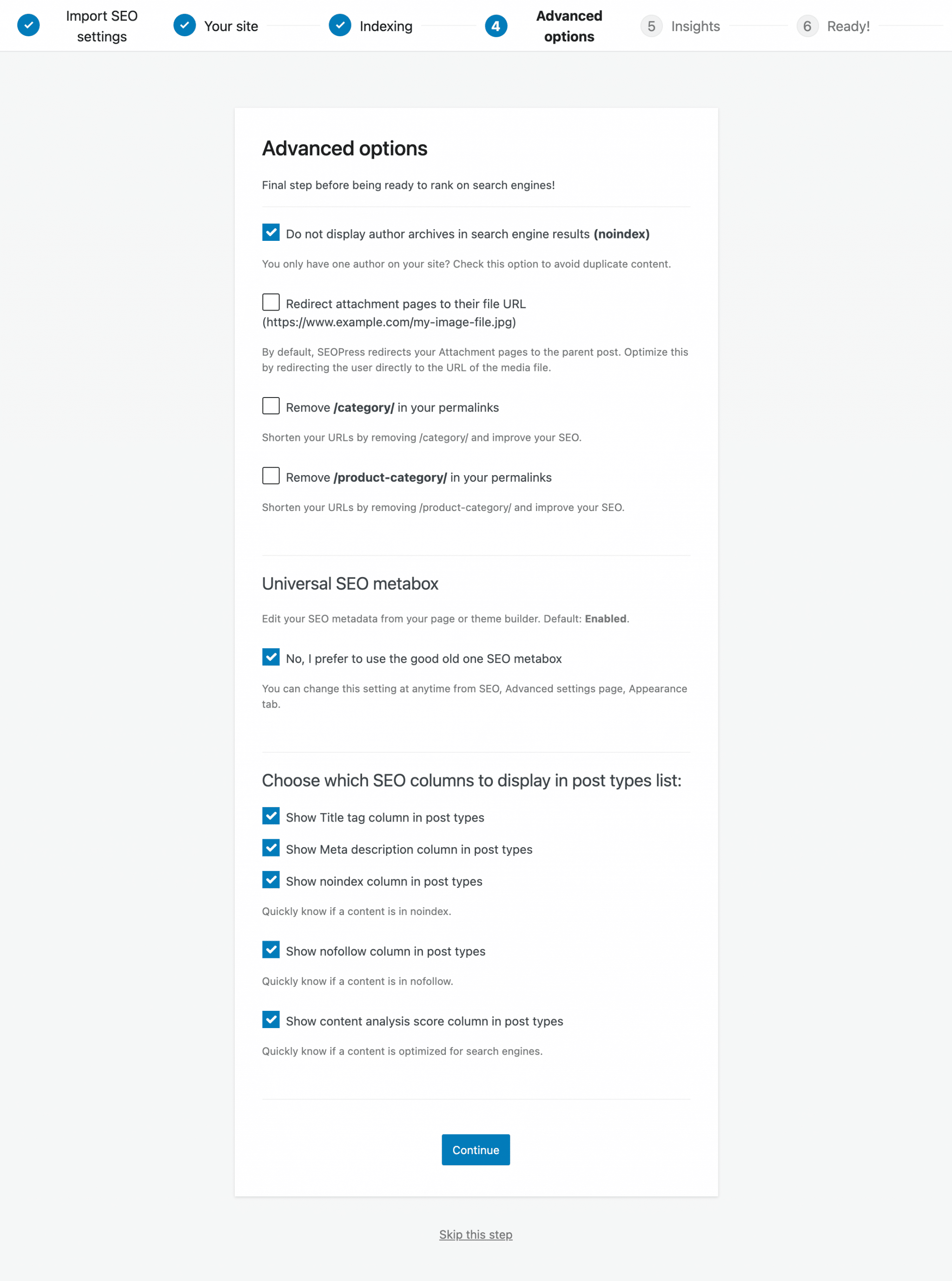
That’s it, the basic configuration is now complete. Before we continue this SEOPress review, the SEOPress Configuration Wizard introduces you to one of its premium services, SEOPress Insights.
SEOPress Insights is a premium tool offered by SEOPress that allows you to track the positions of your keywords and backlinks, within your WordPress dashboard.
It is sold at $99/year per site, with an immediate $20 discount for the purchase of SEOPress PRO + Insights or if you have an active subscription to SEOPress PRO.
Interested in this service? Find out more by watching the video presentation below:

Now, let’s go to the plugin’s Dashboard to dissect the user interface.
Join the WPMarmite subscribers
Get the last WPMarmite posts (and also exclusive resources).

What is the user interface worth?
With the release of version 5.0 of the plugin in the summer of 2021, SEOPress has redesigned its user interface.
It’s clean and intuitive, and easy to use. As Benjamin Denis, the plugin’s developer, points out, this interface is “very much inspired by the WooCommerce administration”:
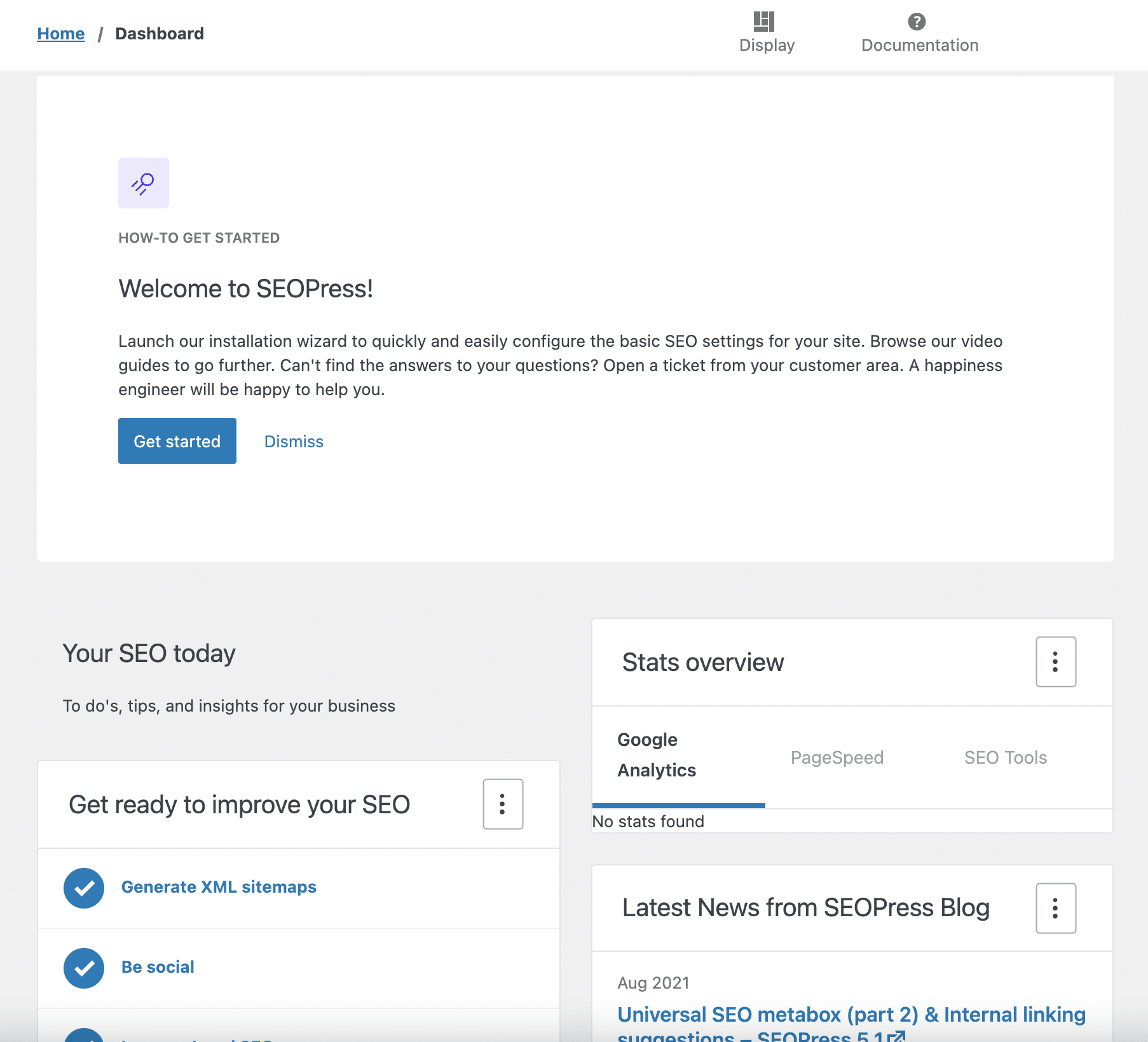
On your dashboard, SEOPress offers practical tips to help you improve your visibility on search engines.
Through several call to action buttons, you are invited to:
- Generate an XML sitemap.
- Configure the Google Knowledge Graph.
- Get an SSL certificate.
- Display more publications per page.
- Create a Google My Business page to boost your local SEO.
- Add your site to Google Search Console.
Finally, and you’re probably expecting it, it is of course possible to configure the settings of your title and meta tags from the SEOPress settings menu.
But to customize even more finely, publication by publication, you’ll have to use the plugin’s editor, or a new very practical feature that appeared in version 5.0 of the plugin.
So, are you curious to know more about this last point? Then go to the next part to find out more.
How to use SEOPress on your website pages?
Option 1: the classic method
As with other SEO plugins, you will find the SEOPress block at the bottom of each page editor under your content editor, in the administration.
The plugin allows you to edit meta titles and meta descriptions, or snippets for Google and social networks:
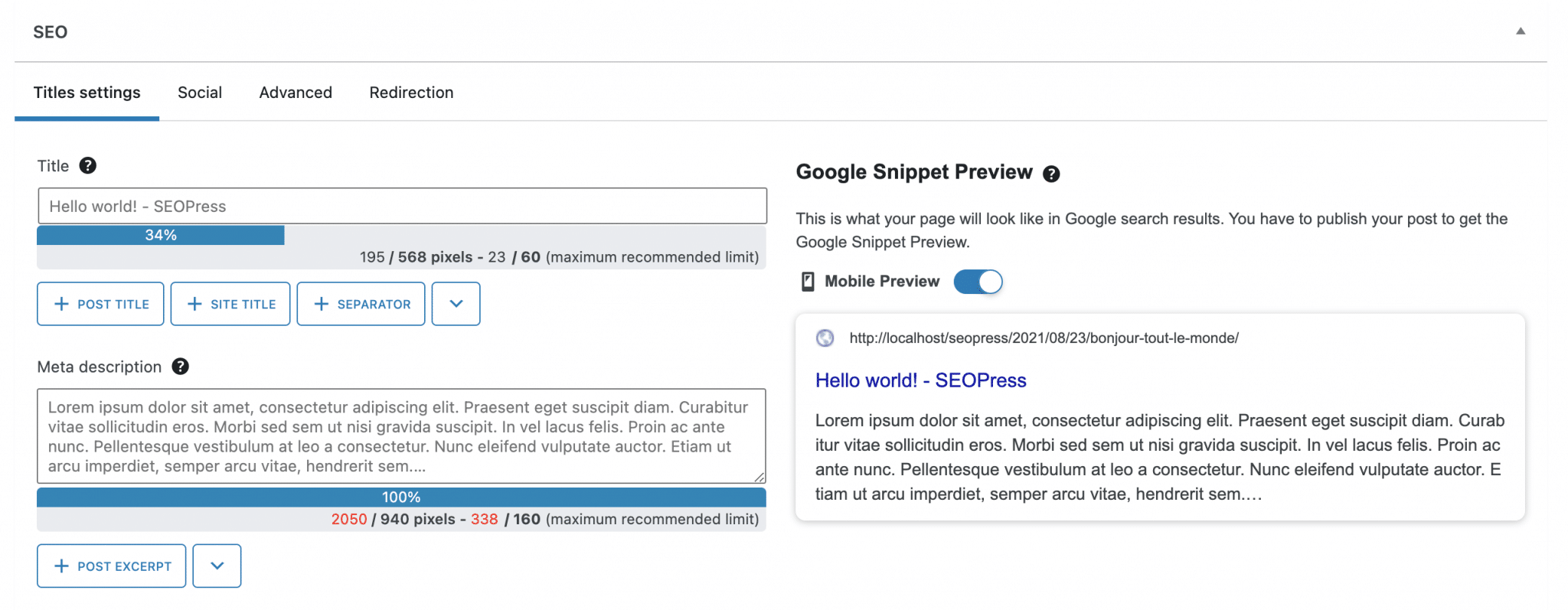
In addition, SEOPress has an advanced and fun content analysis tool.
It appears on each page and on each article of your site and allows you to see at a glance if your content respects the good practices of SEO.
All you have to do is enter the main keyword, and the plugin puts your content through the SEO mill.
Anything that doesn’t have a green light can/should be improved, if possible.
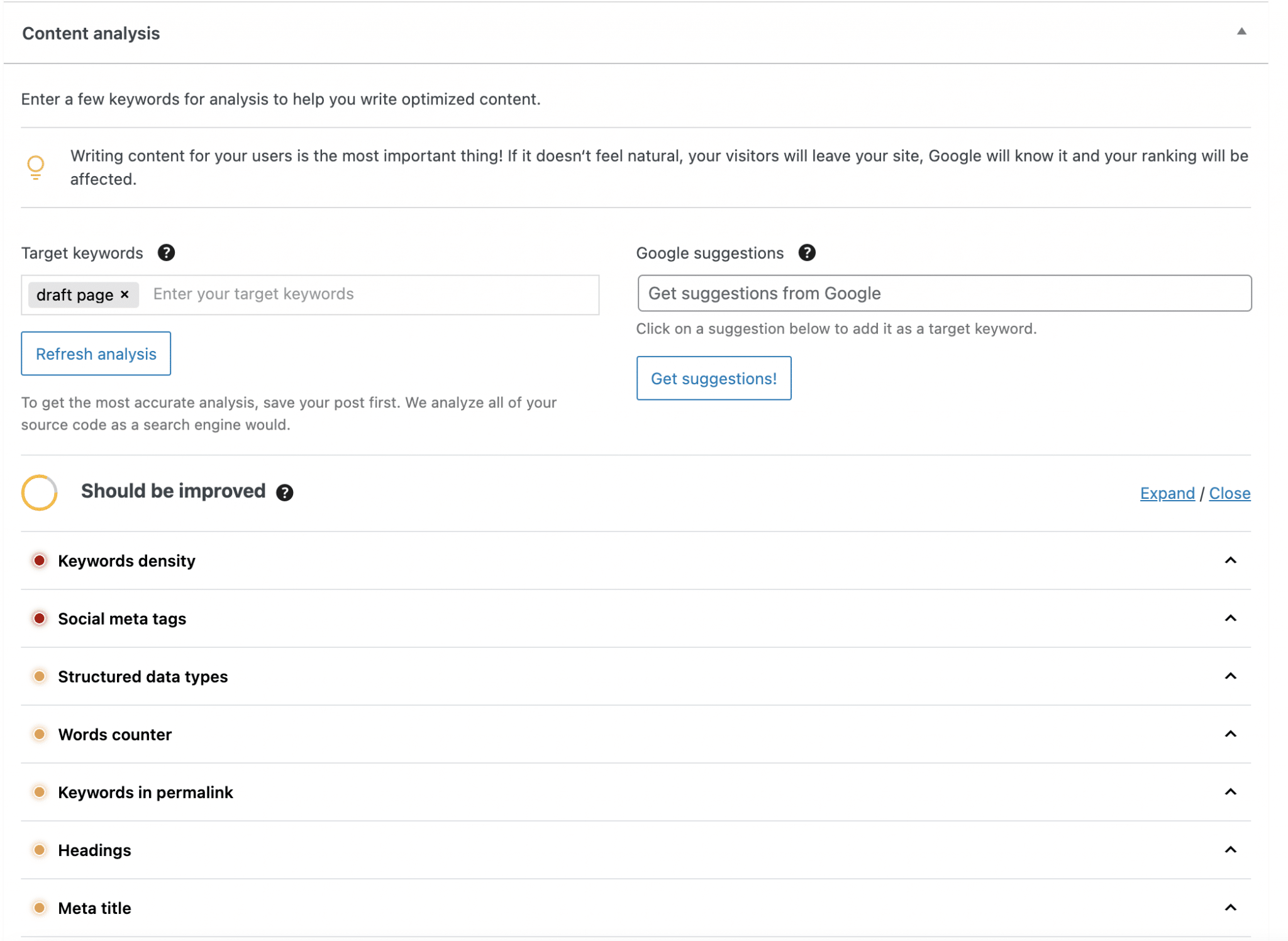
The “Social” tab allows you to edit snippets for social networks:
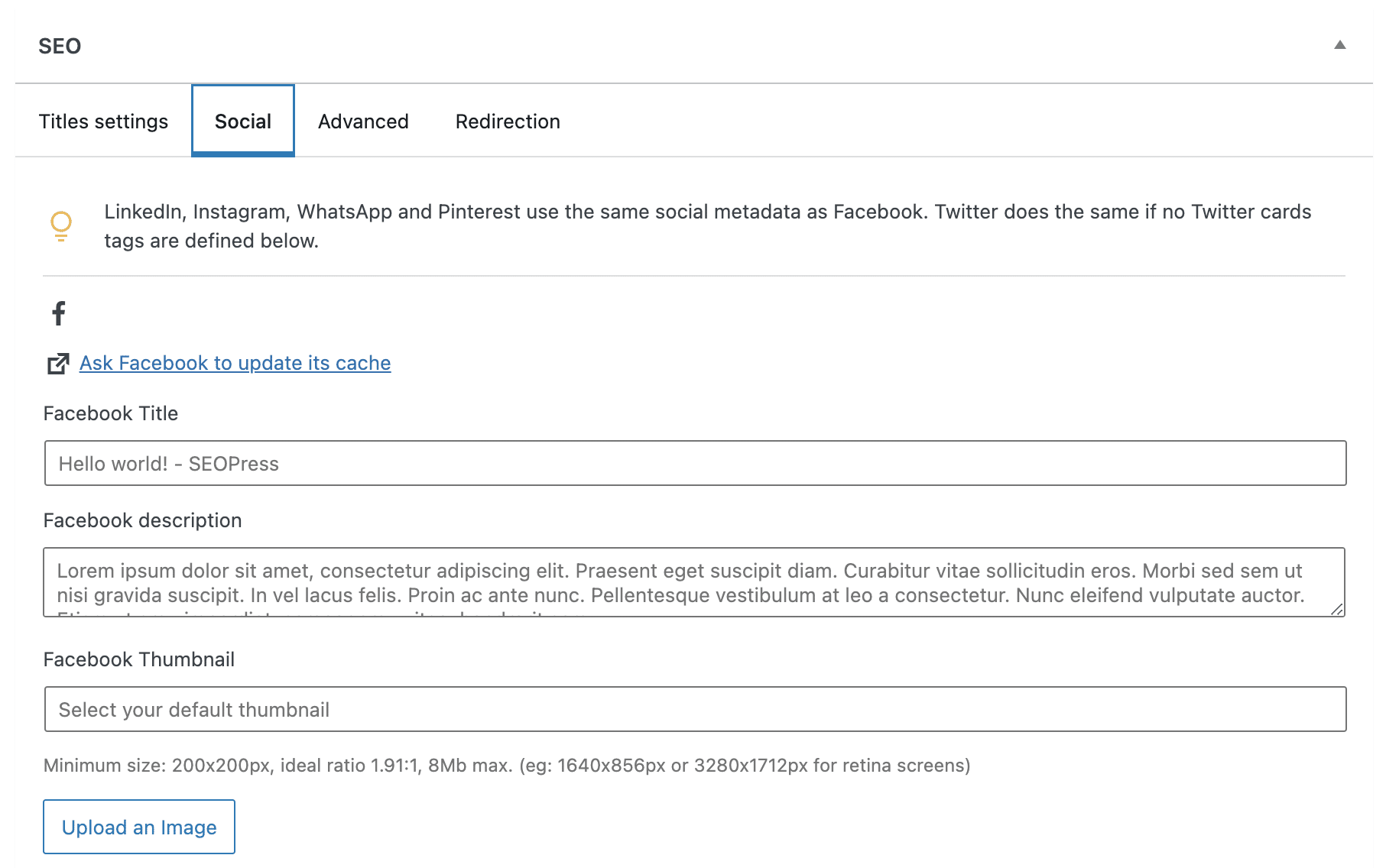
The “Advanced” tab allows you to exclude certain elements from indexing:
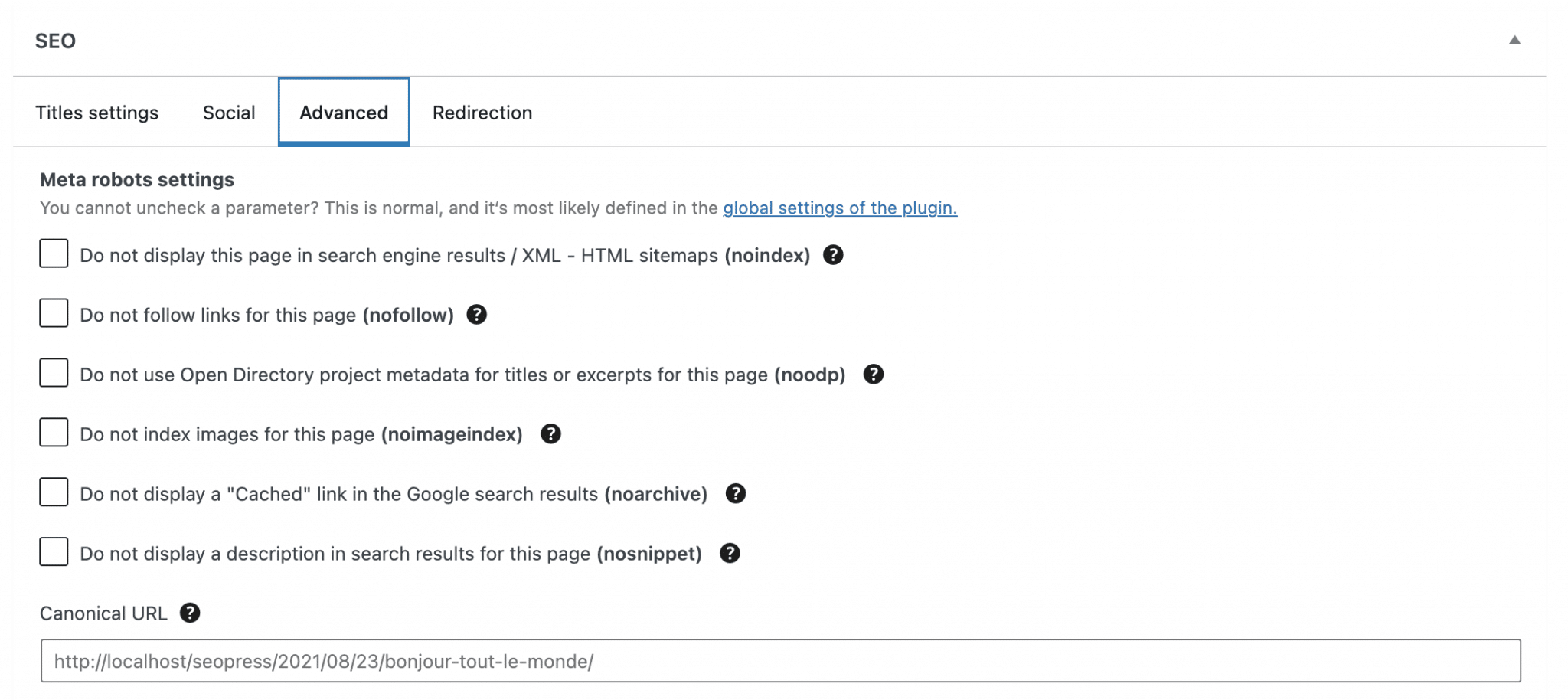
The “Redirect” tab allows you to activate redirects, if needed:
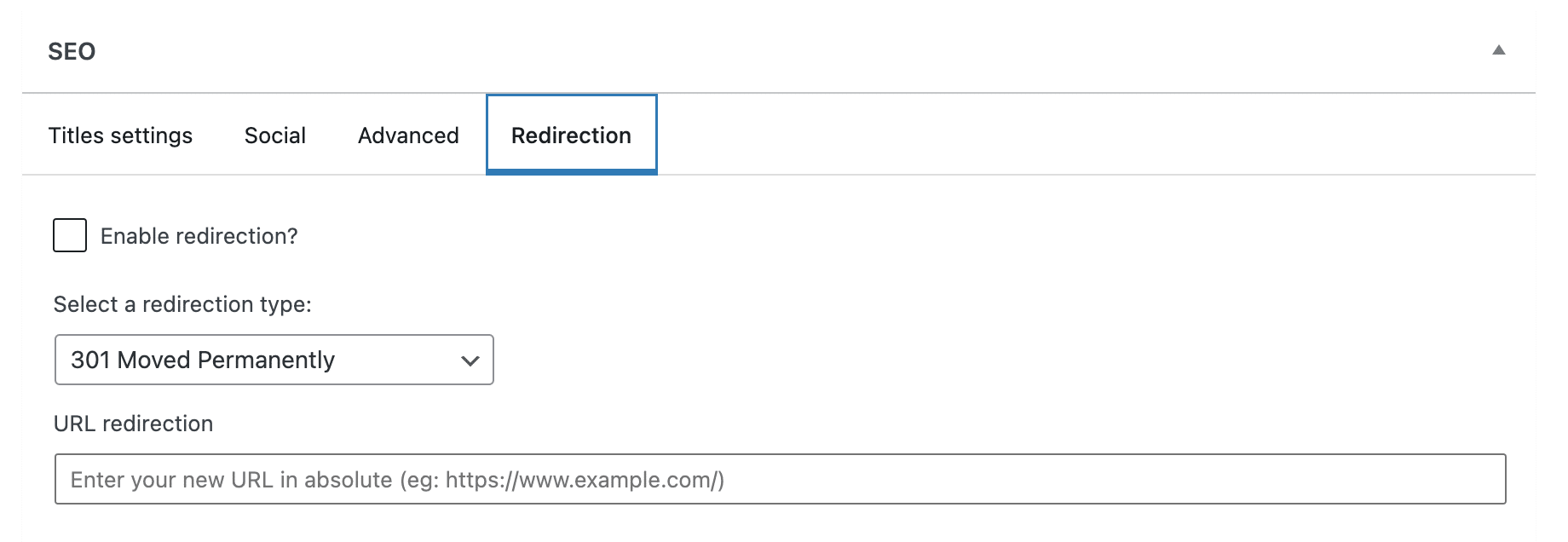
That’s it for the first way to proceed. In this SEOPress review, let’s now move on to the second option, which is brand new at the time of writing this post update.
Option 2: the universal SEO metabox
Since the launch of version 5.0, SEOPress offers a new exclusive feature: a universal SEO metabox, available in the free version of the plugin.
Like the classic editor I just introduced, it also allows you to edit your metadata and analyze your content. So far, nothing extraordinary, then.
The big plus is that this metabox can be used on any page builder (and also on the content editor, Gutenberg).
As SEOPress explains, “no more back and forth between your favorite builder and the WordPress editor to optimize your SEO, everything is now centralized and accessible in one click”.
A page builder is a tool that allows you to create rich and complex layouts for your content, without touching a single line of code, especially through the use of ready-made templates. Editing is often done in drag and drop and in real time.
SEOPress states that its metabox is compatible with 99% of themes or page builders.
For the purpose of this test, we had fun with the page builders Elementor and Beaver Builder. Result: we confirm that with these two, no problem to report.
The use of this metabox is really very simple. On the interface of your favorite page builder, you just have to click on the little purple icon, located at the bottom left of your screen (you can change its position by drag and drop), to make it appear.
Then all you have to do is fill in the settings of your choice:
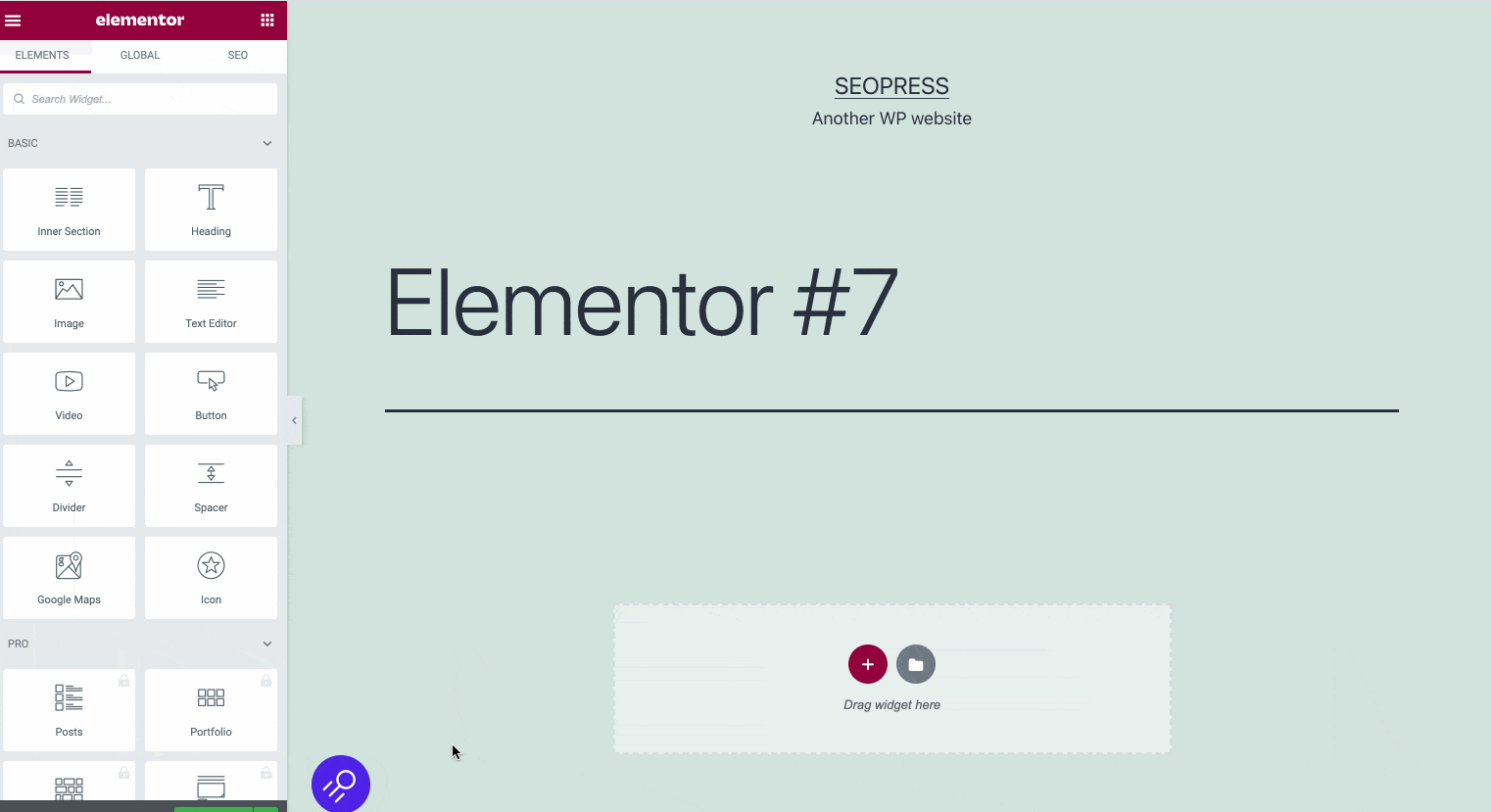
Note that this universal metabox is not activated by default. To benefit from it, go to the menu SEO > Advanced > Appearance. Then uncheck the box “Disable the universal SEO metabox”, and save the changes.
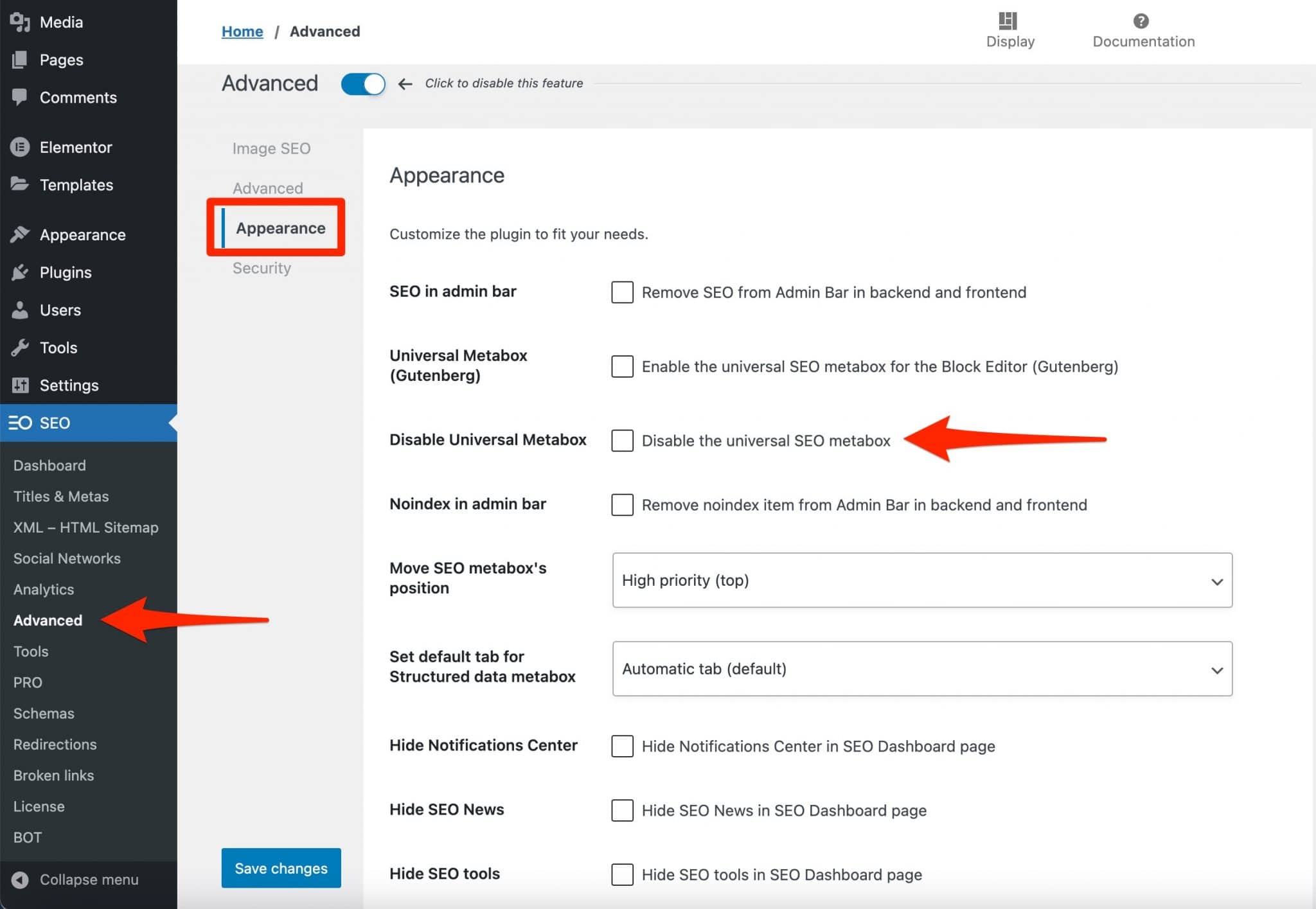
Finally, this universal metabox also allows the user with content editing rights to edit their on-page SEO directly on the visible interface of the site, without going through the content editor.
That’s it for the “technical” part. Now let’s talk about money.
Build your website with Elementor
Design easily the look and feel of your WordPress website with the famous page builder.
Which version of SEOPress should you choose?
As mentioned at the beginning of this SEOPress review, the plugin is available in two versions. First, you can activate it for free through your WordPress administration interface.
A paid version is available for $39/year, with an unlimited number of sites (like the free version, by the way).
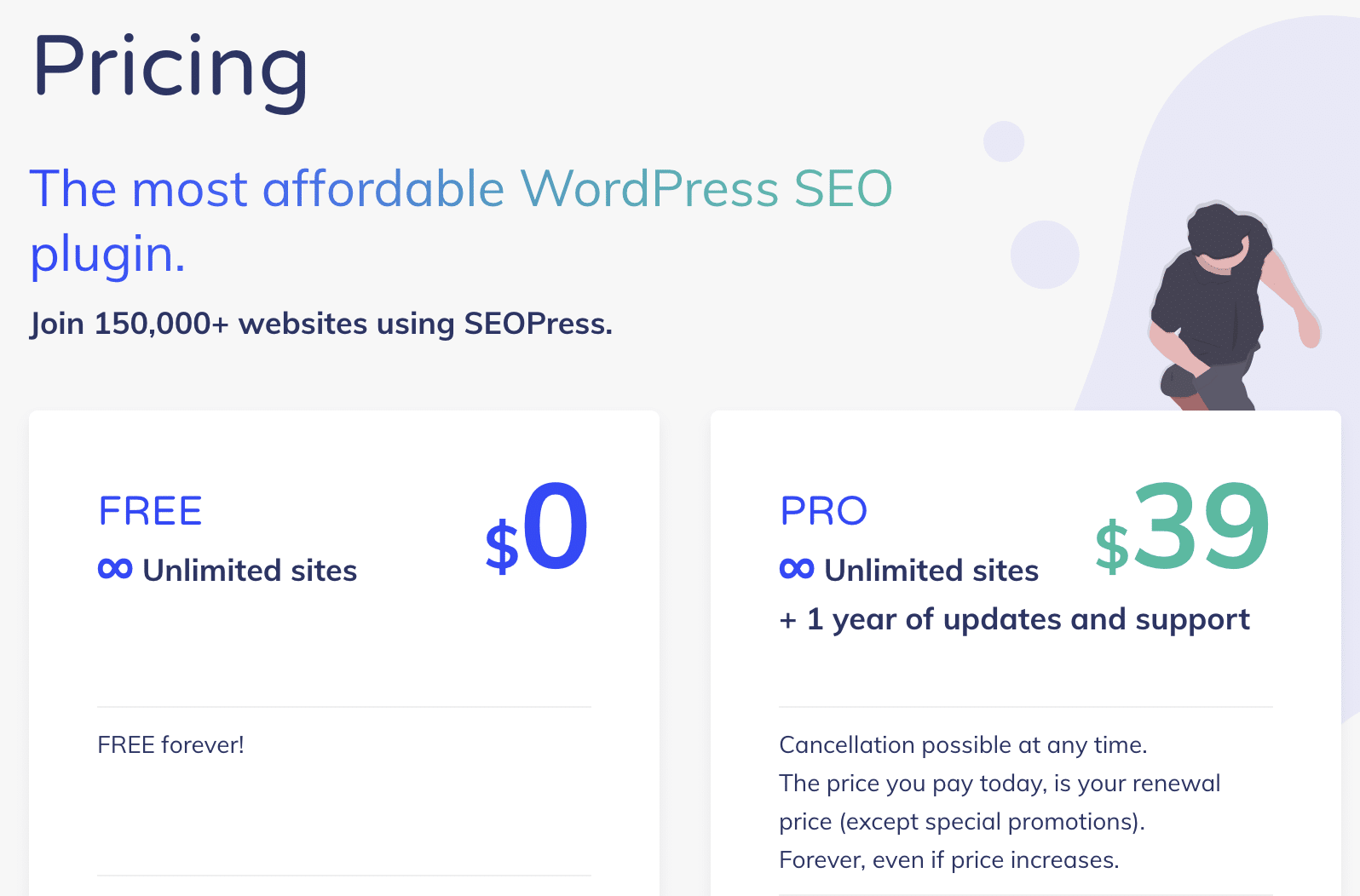
This price gives access to one year of updates and email support. SEOPress also offers a 14-day money back guarantee.
Not sure which version to choose? Here are some tips to help you decide:
- If you are new to SEO for your WordPress site, the free version will be sufficient.
- You want to modify the title and meta description tags first? The free version is also for you.
- You have a WooCommerce store and want to benefit from an advanced ecommerce integration: get SEOPress Pro.
- You have a good knowledge of SEO and want to make technical adjustments in a single interface (redirects, URL rewriting, SEO metadata import/export, monitoring and tracking of your links, etc.): the Pro version is necessary.
Download the SEOPress plugin:
Well, after all that, you deserve a conclusion.
SEOPress review: our final opinion
#SEOPress review: a very complete #WordPress plugin that has many options. Will it overthrow the leader Yoast #SEO?
If the free version is not too heavy and remains quite simple to handle, with essential features for managing the SEO of your site, the creators of the plugin have taken the decision to allow the user to make advanced settings in the Pro version (here it becomes more technical).
SEOPress is therefore not within the reach of a neophyte in SEO, unlike Yoast which is more mainstream.
With a clean and intuitive user interface, SEOPress is easy to use. Its content analysis tool and its universal metabox are very intuitive, which allows you to see at a glance the improvements you need to make.
We appreciate the fact that the plugin is regularly updated and very well maintained, as you can see on the Changelog.
However, we regret a little that some features are only available in the paid package, while some of its competitors include them in their basic offer (Yoast allows for example to perform 301 redirects, to modify robots.txt and .htaccess files, or to add a breadcrumb trail).
By the way, check out this comparison if you want to get a detailed overview of the differences between SEOPress and Yoast.
This SEOPress review is over now but it’s time for you to share your thoughts: have you tested SEOPress on your site? What did you think of it?







